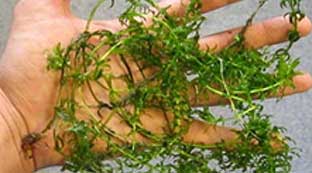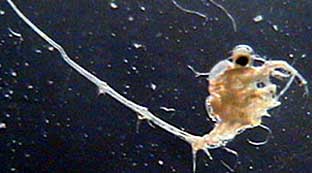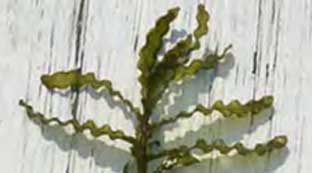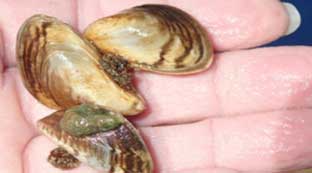BEFORE bringing a boat to Deep Creek Lake, please follow the below guidelines to help protect DCL from AIS:
- Understand the threat AIS pose to a waterbody AND how AIS are transported: Learning more about aquatic invasive species and how they are transported will help you ensure you do your part to clean your boat and remove any AIS. Watch this short 2 minute video to gain an overview of the issues.
- Know the Laws and Regulations: Deep Creek Lake has 2 AIS related laws that are intended to prevent unwanted introductions of AIS and several boating laws specific to DCL. Know the laws to protect you, and the lake!
- Pay attention to what waterbody your boat was last on and when: These two features help determine what AIS to keep a look out for when inspecting your boats and gear and how best to clean or decontaminate your boats and gear. If zebra or quagga mussels are present in the water body of origin, a more thorough decontamination is needed to sufficiently kill and neutralize any water or organisms. For more information on decontamination information and where you can get your boat properly cleaned, click HERE.
- CLEAN, DRAIN AND DRY your boat, trailer and any gear: Visibly inspect the hull, motor, ballast, live wells and any areas that could harbor plants, organisms and any water. CLEAN those areas, DRAIN any standing water, and all allow all parts of the boat and trailer to DRY sufficiently. Recommended drying times may vary with weather conditions…but a minimum of 48 hours is recommended, longer times may be needed if decontaminating for zebra or quagga mussels as these organisms can remain viable for days under certain conditions.
About Deep Creek Lake
Deep Creek Lake is Maryland’s largest lake. It’s located in the far western part of the state in Garrett County. The lake is owned and managed by the state of Maryland and is one of 16 state owned lakes in Maryland. The lake receives many visitors each year, many of which coming from all over the state and the region. Visitors often bring their own boats to Deep Creek Lake and as such, protecting and preserving the ecological integrity of the lake is critically important.
One such threat that particularly boaters from other water bodies bring to Deep Creek Lake, is the threat of introducing a non-native species or an aquatic invasive species (AIS) to the lake and ecosystem. Aquatic invasive species are organisms that are not native to a location and have been shown to cause severe economic and/or ecological impacts to an ecosystem. In the case of Deep Creek Lake, one of the most problematic species of AIS plants in the United States, hydrilla, was first found in the lake in 2013 and managers have spent hundreds of thousands of dollars trying to control the population in the lake since. As with any introduction, it’s rare to know exactly how it happened, but most scientists and managers agree the movement of boats from one water body to the next is one of the biggest vectors, or means of transporting AIS from waterbody to waterbody. While the control effort for hydrilla has been successful to date, the threat of new introductions of hydrilla or other AIS plants and animals remains each year, with every boat that enters the lake.
The Department of Natural Resources and the State of Maryland need the help of boaters and water users to help protect Deep Creek Lake from further introductions of aquatic invasive species. Therefore, it is critically important that visitors bringing boats, gear and live bait follow the laws, regulations and guidelines intended to protect and preserve Deep Creek Lake for all to enjoy.
Understand the threat AIS pose to a waterbody
Aquatic invasive species (AIS) or aquatic hitchhikers are plants, animals or other organisms that are not native to a water body and have been shown to cause severe ecological or economic harm to an ecosystem such as:
- Loss of Biodiversity
- Altered aquatic food webs
- Reduced water quality
- Reduced public safety and health
- Decline in fisheries and habitat
- Damage to infrastructure
- Loss of tourism and recreation
Each year in the U.S. nearly $8 billion dollars are spent on invasive species control and mitigation.
Locally, at Deep Creek Lake, scientists and managers have been spending hundreds of thousands of dollars each year, trying to control one aquatic invasive species hydrilla – a non-native plant. It’s important that the public knows what these plants and animals look like in order to protect Deep Creek Lake and other waterbodies from unwanted, alien species.
AIS Species of Concern for Deep Creek Lake
Below are some pictures of key AIS of concern for Deep Creek Lake. This is only a partial list; to ensure that you aren’t inadvertently transporting an AIS or alien species, be sure to thoroughly CLEAN, DRAIN AND DRY your boats, trailers and gear in between launching onto different water bodies.

Zebra Mussels
(Dreissena polymorpha)
These are small (<1” in length) bivalves that have a flat bottom and attach themselves to any hard surface using strong byssal threads. Zebra mussels are NOT currently found in Deep Creek Lake but are in nearby waterbodies making the prevention of an introduction incredibly important. Nationally, these are one of the most fear species of AIS based on their impacts to an ecosystem, infrastructure, and economy and the difficulty associate with eradicating and controlling known populations. If you suspect your boat was last on a water body with zebra mussels it is CRITICALLY IMPORTANT your boat is properly decontaminated using 140’F or greater hot, high pressure water.
Learn More

Hydrilla
(Hydrilla verticillata)
Hydrilla is one of the most common aquatic invasive species of underwater plants found in freshwater ecosystems throughout the U.S. It usually starts as small circular beds but can quickly reproduce and fill entire coves and water columns causing fish kills, reducing recreational opportunities and altering fish communities. The leaves are whorled around the stem, in clusters of 4 or 5 leaves per whorl, and have visible teeth on the leaf edges.
It was first found in DCL in 2013 and the known populations in the lake are currently being treated and controlled with a herbicide. That said, new populations have been found since 2013, a few of which are likely due to new introductions rather than spread of existing populations within the lake.
Learn More

Spiny water fleas
(Bythotrephes longimanus)
Spiny water fleas are tiny, microscopic animals, known as zooplankton and live in freshwater ecosystems. They are opague in color, have a distintive eye spot, and adults are usually less than a half an inch long, including the tail which has one to four spines. Spiny water fleas are NOT believed to be currently in Deep Creek Lake but could be carried to the lake via contaminated water from other water bodies, making it essential to DRAIN and DRY all compartments of a boat carrying water and not release any live bait or water from a bait shop into the lake.
Learn More

Curly Pondweed
(Potamogeton crispus)
Curly pondweed is a non-native aquatic plant that tends to be more of a threat and nuisance in freshwater lakes. Leaves are usually dark green to reddish/purple in color, wavy, and more rigid than other aquatic plant species.
There have been a few small findings of curly pondweed in Deep Creek Lake, usually at the mouths of tributaries or streams where they meet the lake as the plant likes nutrients and cooler waters. Currently this plant has not reached population levels in the lake that require control.
Learn More

Virile Crayfish (Orconectes virilis) and Rusty Crayfish (Orconectes rusticus)
Virile Crayfish: Varies in color from brown to reddish-brown with green hues; Typically, its large claws are greenish and contain cream or yellow tubercles. Typically found in freshwater, in riffles or pools under large flat rocks or in leaf litter.
Rusty Crayfish: Conspicuous reddish-brown spot on the sides of the body near the tail; only species in Maryland with smooth mandibles (“teeth”). Inhabits riffles and pools, generally under large flat rocks, coarse woody debris, submerged aquatic vegetation, and detritus.
Learn More

Quagga mussels
(Dreissena bugensis)
Quagga mussels are similar in appearance to zebra mussels but they don’t have a flat bottom and tend to be larger, with less stripes. They also have byssal threads and will attached to any hard surface. They tend to prefer deeper waters than zebra mussels and often follow zebra mussels in their colonization of a water body.
Quagga mussels are NOT currently believed to be present in Deep Creek Lake. Like zebra mussels, a more intense and throughout decontamination is required if a boat was last in a water body with quagga mussels.
Learn More
How are AIS Transported from One Water Body to the Next?

Recreational boating is a major cause of the spread of invasive species from one water body to the next. Plants and animals will often “hitch-hike” on a boat and/or trailer from one water body to the next. Many aquatic plants spread quite well from simple cuttings or fragments of plants. So if you motor through a plant bed on one water body or back your trailer into a ramp that has aquatic plants nearby, it’s quite common that whole plants or fragments of plants will become entangled on the trailer, wheels, or bunks of the trailer or attached to the motor of the boat. If the plant fragments are not removed, and the boat is launched onto another water body, the plant fragments can possibly colonize that new water body. Aquatic invasive species such as zebra mussels or spiny water fleas can be transported physically, attached to boats or contaminated gear or via contaminated water. The latter can happen without even being visible to the boat owner…making the proper draining and disposal of all water from a boat, live well, ballast or bait bucket exceptionally important.
Other Vectors...
In addition to recreational boating, other vectors or methods responsible for transporting AIS around the country and world include:
- Aquarium trade – buying non-native plants or animals and releasing them into the environment
- Research activities – scientists may frequently move boats and gear among various water bodies and thus inadvertently transport AIS.
- Releasing unused bait – improper disposal of unused bait can transport
Know the Laws and Regulations
There are two Maryland State laws that protect Maryland waterbodies and lakes from aquatic invasive species:
Code of Maryland Regulation (COMAR) 08.02.19.05 General.
A. A person may not place or attempt to place upon or into State waters a vessel or associated equipment with attached or contained aquatic plants, zebra mussels, or other prohibited species of nonnative organisms.
B. Water taken from waters infested by prohibited nonnative species may not be diverted, appropriated, or transported on public roads except in the following circumstances: (1) In an emergency declared by appropriate local or State authorities, such as a fire emergency; (2) As specified in water appropriation or public waters work permits; or (3) Under a permit issued by the Secretary.
In addition to any other penalty provided under law, a person who violates a provision of this section or a regulation adopted under this section is guilty of a misdemeanor and on conviction is subject to imprisonment not exceeding 30 days or a fine not exceeding $ 2,500 or both for each offense, but not exceeding a total of $ 25,000 for offenses arising out of the same enforcement action.
Natural Resources Article §8–703.3.
(a) This section applies to a vessel that is operated in a lake that is owned or managed by the State.
(b) After April 1, 2017, an owner of a vessel may not place the vessel or have the vessel placed in a lake at a public launch ramp or public dock unless the owner has cleaned the vessel and removed all visible organic material.
(c) An owner of a vessel who violates this section is subject to a civil penalty not exceeding:
(1) $100 for a first violation;
(2) $250 for a second violation; and
(3) $500 for a third or subsequent violation
INSPECTION and DECONTAMINATION PROCEDURES
Many aquatic invasive species (AIS) can spread into new water bodies from plant cuttings, microscopic larvae attached to your hull, motors or engines, and/or mud or other substrates on your boat, trailer, engine or equipment. As such it is important that you thoroughly INSPECT and CLEAN all aspects of your boat, trailer and gear before launching your boat on to Maryland’s lakes and waterways. It’s not only the law but by doing so, you will help protect Maryland’s waterways and be a good steward of our precious aquatic ecosystems. THANK YOU for your help!
The following information will walk you how to conduct a vessel self-inspection and preform any necessary cleaning or decontamination needed and prevent ANS introduction to our waterways. You can use the HEAD acronym to help insure that you’ve thoroughly checked, cleaned and cleared all parts that come in contact with water.

Hull and trailer
- Look and feel over entire craft on both sides of hull and trailer; Remove any plant fragments, mud or debris that is present. If hull is rough, consider pressure-washing
- Physically inspect the through hull fittings and check trailer bunks, rollers, tire wells, lights and electrical wires and remove any debris or mud present
- Remove bilge plug when inspecting transom. Activate bilge pump and allow it to empty onto a dry surface (not back into the water body). Feel bilge area and use a flashlight to see if there are any AIS) present
- If craft has inboard engine, inspect prop, prop shaft and rudder
Engine or Motor
- Lower the engine and visually inspect the engine and gimbal area with a flashlight
- Check the transom, outboard, propeller, wires and lines, and rear of the boat for any AIS
Anchor and equipment
- Inspect the anchor and rope/chain for mud, plants or AIS and remove if present
- Inspect life vests and all other equipment (SCUBA gear, fishing gear etc) and decontaminate if necessary
Drain and check interior compartments and Dry EVERYTHING
- Drain all live wells, bilge, ballasts or interior compartments and allow to dry.
- Dry your boat, trailer and any equipment or gear that has come in contact with infected waters properly before launching on a different water body. Drying times vary with climate, weather, and seasons but general guidelines are as follows:
- at least 7 days in SUMMER
- 18 days in SPRING or FALL
- 30 days in WINTER
** If you have recently boated on a water body such as the Chesapeake Bay or a body of water known to have AIS, especially zebra mussels or quagga mussels, it is recommended you take additional steps to decontaminate your boat. These include cleaning your boat and equipment with HOT (>140°F), high pressure water for a minimum of 10 seconds on any contaminated surface to kill and remove ny organisms present. Additionally, allowing any contaminated boats or gear to dry for at least 5-7 days will reduce the chance of any organisms remaining viable. This is the BEST way to thoroughly decontaminate any boat or gear that has AIS present.
If HOT, high pressure water is not available, a 10% bleach solution (10% Bleach, 90% water) can used to clean parts of the boat that have come in contact with infected water. Be sure to do this away from any water body, as even the smallest amount of bleach can be damaging to fish and aquatic life. The solution will kill any microscopic larvae, bacteria or other material that you could inadvertently be transporting. However, this approach may NOT sufficiently kill zebra and quagga mussels. As such it would be important to find a marina that has been trained in AIS decontamination and can provide HOT, high pressure power washing. For a list of locations at Deep Creek Lake, that can decontaminate your boat, click HERE.
For additional questions/concerns, please email Julie Bortz (MDNR Natural Resource Biologist) at [email protected] or refer to MDNR’s AIS website at http://dnr.maryland.gov/invasives
Locations at Deep Creek Lake where you can get your boat inspected, cleaned and DECONTAMINATED
You are strongly encouraged to have your boat cleaned and/or decontaminated BEFORE you bring your boat to Deep Creek Lake. If you bring your boat to Deep Creek Lake and it has not been properly CLEANED, DRAINED and DRIED, you should anticipate this process may take some time and you should plan accordingly. Launch Stewards are available at the Deep Creek Lake State Park boat ramp and can inspect your boat for any AIS. They staff the boat ramp and offer FREE voluntary boat inspections from Memorial Day through Labor Day and you are encouraged to have these trained inspectors inspect your boat. Should you need to have your boat inspected (outside of the launch steward dates or hours) and you need to have your boat cleaned and DECONTAMINATED, there are several local marinas at Deep Creek Lake that can both inspect your boat and clean or DECONTAMINATE your boat. These marinas include:
- Deep Creek Marina or Lake Life Marina (McHenry, Maryland)
- Silver Tree Marine (McHenry, Maryland)
- Here to Help LLC (Bloomington and Swanton, MD)
- The Aquatic Center (McHenry, Maryland)
These marinas and local contractors have received necessary AIS training and should be able to properly CLEAN and DECONTAMINATE your boats. There is a cost associated with cleaning and decontaminating your boat and prices likely vary with the size of your boat and how infected it is with AIS. You are encouraged to plan ahead and contact the marinas well in advance of your arrival if you need to schedule a cleaning or decontamination. Failure to do so may result in delays to your ability to safely and legally launch your boat onto Deep Creek Lake.
It is strongly encouraged to try and have your boat cleaned and decontaminated closer to your home location, or at the place where you pulled your boat out of the water as local marinas should be aware of what AIS are in their waterway and better able to sufficiently clean and decontaminate your boat. This would additionally afford you ample time to allow your boat to dry for at least 5-7 days before moving it to another water body. Doing so will also hopefully reduce your risk of transporting any AIS along the highway or over state boundaries and violating any state or federal laws prohibiting the transport of invasive species across state boundaries.
Other marinas and service centers are also located in the Deep Creek Lake area. You can contact the following marinas and inquire as to what cleaning and decontamination services they are able to provide.
- Bills Marine Service Center (McHenry and Swanton, Maryland)
- Patterson Boats (Swanton, Maryland)
It should be noted that HOT (>140’F), high pressure water is required to be used to properly decontaminate a boat that has been infested with zebra or quagga mussels.
If you have questions reach out to Julie Bortz at
[email protected] or call 301-387-4112.
